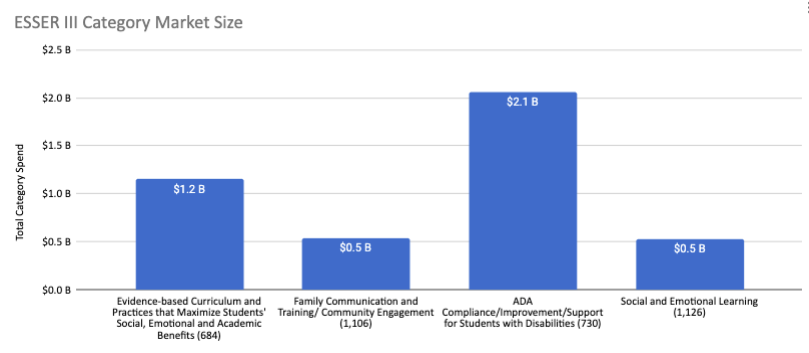1. In previous blogs we have covered examples of initiatives covering mental health, student engagement, and attendance across K-12. This week we drill down on the number of districts spending in these areas, plus areas such as social and emotional learning and support services. Figures below are taken from Burbio's dataset of 6,000 ESSER III plans covering $92 billion in spending across K-12. The charts show the number of districts spending in each area and the amount of money being allocated.
 |
 |
In examining tens of thousands of pages of school district ESSER III plans, one of the issues we worked through was how to categorize spending. In general, we found that the wide latitude given to districts to describe their use of funds has led to interesting descriptions and programs that appear to be tailored to district needs. The inconsistency in descriptions and bundling, however, makes it difficult to preserve granularity without some redundancy.
For example, the category "Evidence-based Curriculum and Practices that Maximize Students Social, Emotional, and Academic (emphasis ours) Benefits" is a term used by the Federal Government and applied by many districts verbatim in their plans. A similar category - "Social and Emotional Learning" - is a variation used by many districts but does not bundle in "academic." While there is very likely considerable overlap in the elements in these categories, we separate them to allow our corporate, research, and policy partners to make their own decisions about how to apply the information.
In all, the categories listed above total just under $8 billion in spending.
2. In future weeks we are going to be looking at energy spending and investments in school budgets, which represents one of the largest non-personnel expenditures for K-12 districts nationwide and are often focused on energy efficiency and sustainability. This week we start on a slightly less capital intensive note, featuring examples of celebrations of environmental initiatives that are a common theme of local districts. From across the US:
- Farmington Public Schools, AR opened a "375 kW-AC solar array on-site at Farmington High School, 250 kW-AC array at Jerry Pop Williams Elementary School, and the completion of a district-wide energy-efficient upgrade," at the end of September. The full release says the initiative will save $300,000 annually. "With more than $6 million in savings to be realized over the lifetime of this project, FSD will use the savings to fund teacher retention initiatives and classroom advancement. . . ."
- Chappaqua Central School District, NY is opening a "Sustainability Research Center" at their high school. "Perhaps the first of its kind on a high school campus, the Sustainability Research Center (SRC) is a free-standing, 2,000+ sq. ft. climate-controlled, multi-zoned, glass research laboratory with adjoining head house classroom space for studying plant sciences and preparing materials to be used in the SRC," reads the district website.
- Richland School District 2, SC operates a biodiesel production laboratory, which converts used cooking oil into biodiesel fuel. The "Bengal Biodiesel Lab" is one of only two of it's kind in the United States. At the ribbon-cutting last spring, the release notes, "The event will end with the student made biodiesel fueling the school’s tractor . . . "
- Pueblo District 70, CO installed four solar greenhouses, one each at four different district schools. "The integration of greenhouses will support many nutritional and educational efforts. Great things are happening in our district!" reads the announcement.
- Mount Desert Island High School, ME features this page that monitors the energy the district is generating from their solar array.
-
At Oxford Academy, a school in the Anaheim, CA school district, a student-led group is spearheading an effort to collect 1 used million batteries. The group, formed last November, is up to 300,000.
- In Chelmsford Public Schools, MA the high school's ecology club has launched a composting initiative. The group's advisor, and student members, "still need to be present at lunch to direct students where to place their waste," reports the Superintendent. "Ecology Club's goal is that 100 percent of the students will compost properly by November to eliminate the need for club members to supervise at the bins . . . "
- Battiest Public School District, OK is using ESSER funds to buy propane route buses, with projections to "save $25,000 this year . . .and over $75,000 in repair costs." Santa Fe Public Schools, NM is using a grant from a state settlement fund to purchase three electric school buses. "Replacing buses that are more than 10 years old and diesel-powered with alternative-fuel buses will result in reduced tailpipe pollution, greenhouse gas emissions and lowered fuel costs. . . ." says the Superintendent.
- Broward County Schools, FL is holding a “'How Low Can You Go Challenge,'” which encourages schools to reduce the amount of energy and water they consume throughout the school year" reads the announcement. "Maplewood Elementary took first place in the District last school year for having the largest decrease in kilowatts used, as compared to the previous year. The pep rally also celebrates Green Sports Day, which helps connect environmental stewardship with athletic events. . . ."